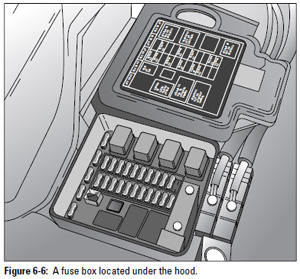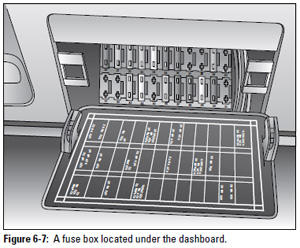If your stereo goes dead, your turn signals don't blink, a light goes out, or some other gadget stops working, it's often just the result of a blown fuse.You can change fuses yourself, easily and with very little expense.
Many vehicles have two fuse boxes: one under the hood and one under the dash. A fuse box is easy to recognize (see Figures 6-6 and 6-7), and replacing burned-out fuses is a fairly simple matter. Changing a fuse is much cheaper than paying for new equipment or repairs that you don't need (even if you chicken out and have an automotive technician do it), so take a few minutes to find your fuse boxes. Your owner's manual can help you locate them.

Caution: Before you open or work on a fuse box, be sure that your vehicle's ignition is turned off.
Caution: Never replace a fuse with one that has different amperage than the original. The new fuse has to be the same color and size as the one you're replacing. As you can see in the figures, the lid of each fuse box usually has a chart that shows you what each fuse is for and how many amps it is. If the fuse you're replacing has different amperage than the one on the chart, someone mayhave replaced it incorrectly, and that may be why it's blown.
After you've replaced all the burned-out fuses, test the part that malfunctioned to see if it's operating properly again. If it still doesn't work, have it professionally repaired or replaced.

Blade-Type Fuses
Most modern vehicles have blade-type fuses with prongs that plug into the fuse box the same way that appliances plug into wall outlets (see Figure 6-8). They come in various sizes and are colorcoded for amperage.
If you can't just yank a fuse out, you need a plug puller. If you're lucky, your automaker has provided one right in the fuse box. If not, try a pair of tweezers.
You can tell if the fuse has blown by looking at the filaments visible in its little window. If they're fused (no pun intended) or burned through, the fuse has had it.
Tubular Fuses
If you encounter tubular glass fuses, look for one that's black inside or no longer has its filaments intact (see Figure 6-9). To remove this blown fuse, gently pry it out with your fingers, a very small standard screwdriver, a small set of pliers, or, as a last resort, a bent paper clip.
Tip: To avoid breaking the fuse, try prying up one of the end caps first. If that doesn't work, gently pry it up from one end of the center area. Inspect the fuse to be sure it's burned out, and then gently press a new fuse into place.

|
From Auto Repair for Dummies, copyright © 2009 by Wiley Publishing, Inc., Indianapolis, Indiana. Used by arrangement with John Wiley & Sons, Inc.










